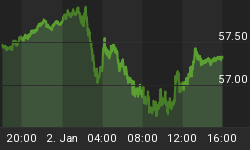One question I often receive is how much money an investor should put into the precious metals. There is no simple answer, yet I want to remain consistent. When I wrote The Ten Rules of Silver Investing, it was stated that 10% was enough of a diversification. Since that book was published nearly a decade ago, I have told my readers that perhaps an allocation of up to 20% might be considered, due to the current economic environment on a worldwide basis.
In 2005, Ibbotson Associates prepared a study for Bullion Management Services Inc. This was the first modern asset allocation model that really defined the problem of true asset diversification, and it proposes a real world solution. On page 3 of this study we find, "Based upon the forward-looking resampled, efficient frontiers, asset allocations that include metals have a better risk-adjusted performance (as measured by the Sharpe Ratio) than asset allocations with the precious metals. Investors can potentially improve the reward-to-risk ration in conservative, moderate, and aggressive asset allocations by including precious metals with allocations of 7.1%, 12.5%, and 15.7%, respectively. These results suggest that including precious metals in an asset allocation could increase expected returns and reduce portfolio risk."
Let me further a couple of points. First, the Ibbotson study is talking about physical metals owned outright, the real deal, not any type of derivative. Secondly, without real metal in your portfolio, you really are not diversified. This is probably a shock to both non-professionals and professionals alike, but this study does a good job of convincing any serious thinker that the bond/stock diversification model is flawed in today's world. Many a certified financial planner should seriously consider this study required reading before their clients ask the all too obvious question: Why wasn't my portfolio diversified properly?
In this latest video below, I answer some questions about precious metals allocation.
http://www.moneyshow.com/msc/investors/playerCust.asp?v=2086&scode=011490
Another view that takes a deeper look, not only at asset allocation but also at what to expect for the precious metals complex going forward, is available at www.HoweStreet.com.
http://www.howestreet.com/index.php?pl=/fbn/index.php/mediaplayer/288
Another question I often receive is how to maximize your investment returns. I'm a long-term guy and along with several others have talked about how to make big, big money in any investment arena. The way to do it is to buy relatively early into the cycle and hold on through all the ups and downs, all the squiggles and wiggles, all the wear-you-out and scare-you-out kinds of moves, and then wake up a decade later and take an accounting.
This basically means a hold period of 10 years, a full decade. What is easier than to buy relatively early in the cycle and go on vacation for 10 years, come back and take a look, and say, "My goodness, am I rich or what?" But people don't have that kind of psychology, they just don't have it. I think my main job is education -- educating people about honest money or the benefits of a sound financial system. But my second job is to teach them to be patient and have conviction in their investment holdings, because without that conviction the bull is probably going to shake them off on the way up. There are very few people (when this cycle ends) who will have made the substantial money that was available to them. That's really too bad, because there's nothing more discouraging to anyone in the investment arena than to be right but have gotten out too early.
To use a baseball analogy, we would be probably in the fourth or fifth inning. The seventh inning is when we're going to shift the sentiment, probably to optimistic, and it's going to be the bottom of the ninth when we're going to see what I call the mania, or the euphoric stage. Coming back to the penny stocks, that's when any stock with the name gold or silver in it will be going crazy because the general public will come in right at the top of the market. They'll be looking for any mining stock that's cheap and has gold or silver in its name, and believe me, they will pile into those stocks like crazy.
In conclusion, many in this sector are getting worn out and wondering if they should continue to hold or not. In my view, do not let the bull shake you off! Hold on tightly and think about getting an even tighter grip.
It is an honor to be,
















